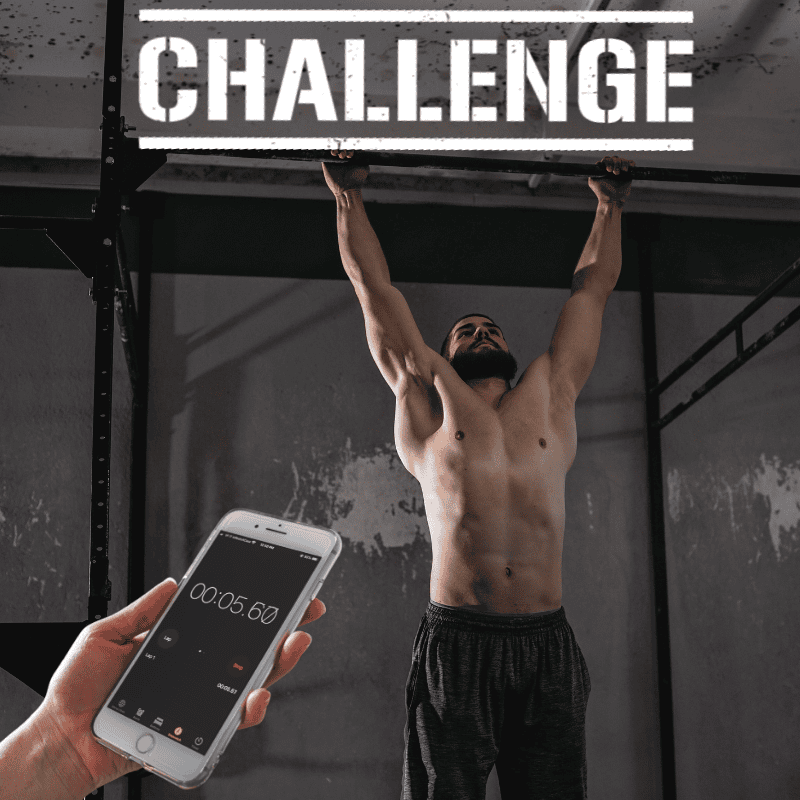Hanging from a pull-up bar might seem basic, but it’s one of the most fundamental skills in calisthenics. A strong, confident hang is the foundation for so many key movements—pull-ups, muscle-ups, leg raises, and even dynamic transitions. If you’re not comfortable hanging, you’re missing out on unlocking your full potential in calisthenics.
That’s why I created this 28-day calisthenics challenge: to help you not only improve your max hang time but also build the grip strength and endurance essential for mastering advanced skills.
Grip strength isn’t just important for calisthenics—it’s a cornerstone of overall fitness. A strong grip improves your performance in countless exercises, protects your wrists from injury, and even carries over to everyday activities like carrying groceries or opening jars. Plus, studies have shown that grip strength is a strong indicator of overall physical health.
This challenge is designed to help you develop this critical skill, whether you’re working out at home or in a calisthenics park, using nothing more than a pull-up bar, a resistance band, and your own bodyweight. Two resources I can recommend here:
▶️ Tips for training outdoors in winter
▶️ Essential calisthenics equipment
Over the next 28 days, you’ll focus on building strength, endurance, and confidence on the bar. The program is accessible for all fitness levels, with progressions and variations to keep you challenged. By the end, you’ll not only see a huge improvement in your hang time but also feel stronger, more capable, and ready to take your calisthenics journey to the next level. Let’s get started—your grip game is about to get serious!
28-Day Dead Hang Challenge: Workout Plan
This program is designed to help you build grip strength, forearm endurance, and core stability to improve your max hang time. With 13 workouts spread over 28 days, you’ll progressively challenge yourself while incorporating rest days to recover and adapt.
Program Structure
• Day 1: Test your max hang time (no workout).
• Days 2-27: Alternate between workouts and rest days (13 workouts total).
• Day 28: Retest your max hang time.
Each workout is designed to be completed in 30-40 minutes, focusing on exercises that require only a pull-up bar and resistance bands. Variations are provided for all fitness levels.
Required and Recommended Equipment
Required Equipment for the Challenge:
- Pull-Up Bar: Any sturdy bar will work, such as a doorframe pull-up bar, freestanding pull-up bar, or one in an outdoor calisthenics park.
If you want to get the perfect home gym set up check this out: ▶️ Best pull-up bars for calisthenics
Recommended Equipment:
- Resistance Bands: Useful for assisted hangs and pull-up progressions.
- Liquid Chalk: Helps keep your hands dry and improves grip, especially during longer holds.
- Calisthenics Gloves: Provide additional grip and protect your hands, especially if you’re new to bar work or prone to calluses.
- Gymnastics Rings: A versatile alternative to a pull-up bar; they can increase grip difficulty due to instability.
- Tape or Grip Wraps: Wrap the bar to improve grip, especially if it’s slippery or smooth.
Set-up and Testing
The first step in this challenge is to test your max hang time, which sets a benchmark for the progress you’ll work toward over the next 28 days. On Day 1, you won’t be doing a workout—this day is solely dedicated to assessing your current grip strength and endurance. The same applies to Day 28, when you’ll retest your max hang time to measure how much you’ve improved. Testing on these specific days ensures you’re starting and ending the challenge with fresh hands and full energy, which is key to getting accurate results.
To test your max hang, find a bar that’s sturdy and safe to grip. You can use a doorframe pull-up bar, freestanding bar, gymnastics rings, or even an outdoor setup in a calisthenics park. Keep in mind that the thickness of the bar can influence your performance—a thicker bar requires more grip strength, making the hold more challenging. If you’re using a thinner bar, your hang time might naturally be longer. No matter what equipment you use, make sure it feels secure and allows you to hang freely without your feet touching the ground.
If you’re worried about sweaty hands or losing your grip prematurely, consider using grippy calisthenics gloves or applying liquid chalk to keep your hands dry. These tools can help you focus on your endurance and strength rather than battling slippery hands. When you’re ready, grip the bar (either overhand or underhand) and hang with your arms fully extended, maintaining proper form until you can no longer hold. Record your time and make a note of the equipment and bar thickness you used so you can replicate the same conditions on Day 28.
Workout Plan for Increasing Hang Time
The workout plan for this 28-day challenge is carefully structured to help you build grip strength, endurance, and full-body control while allowing enough rest for recovery and progress. With 13 workouts spread throughout the challenge, you’ll alternate between workout and rest days to give your muscles time to adapt and grow stronger. Day 1 and Day 28 are dedicated to testing your max hang time, with no workouts scheduled on these days, so you can focus fully on measuring your performance and seeing how far you’ve come.
The exercises in this plan were selected to target the essential components of hanging strength: grip endurance, forearm and wrist activation, and core stability.
Dead hangs and active hangs directly improve your ability to hold the bar for longer periods, while exercises like scapular pulls and resistance band drills strengthen the supportive muscles around your shoulders and wrists.
Core-focused movements, such as L-hangs or knee-to-chest holds, are included because a stable core helps you maintain better form and reduces wasted energy while hanging.
The plan is designed to be progressive, offering easier and harder variations to match your fitness level and ensure that every session challenges you appropriately without leading to overtraining. This combination of strategic targeting and progressive overload ensures steady, sustainable improvement in your hang time.
Targeted Warm-Up Before Each Workout
A proper warm-up is essential before starting any workout, especially when focusing on grip strength and hanging exercises, as it helps to prepare your muscles, joints, and connective tissues while reducing the risk of injury.
Each session begins with a 5-minute warm-up designed to increase blood flow, loosen tight areas, and activate the muscles you’ll be using on the bar.
Start with arm circles: hold your arms out to the sides and make small, controlled circles, gradually increasing the size. This movement warms up your shoulders and improves mobility.
Follow this with wrist rolls—extend your arms and rotate your wrists in both directions to prepare your forearms for the grip work ahead.
Dynamic stretches are also a key part of the warm-up. Do shoulder swings by gently swinging your arms forward and backward, crossing them in front of your body to loosen your chest and shoulders.
Incorporate bar-specific prep by performing light dead hangs: grip the bar and hang loosely for 10-15 seconds, focusing on engaging your grip lightly and warming up your shoulder joints.
For additional activation, use resistance bands for band pull-aparts or scapular retractions to wake up your upper back muscles.
This combination of dynamic movement and targeted activation ensures that your body is primed for the main workout, improving your performance and reducing strain on your joints and muscles.
Workout Days Between Day 2 and Day 27
Each workout in this program is designed to target specific aspects of grip strength, endurance, and core control, and they are broken down into three categories:
- Workout A,
- Workout B, and
- Workout C.
You’ll rotate through these workouts in order, ensuring a balanced approach to your progress. For each exercise, you’ll find easier and more advanced variations, allowing you to customize the difficulty based on your fitness level. Start with the version that challenges you without compromising form, and as you build strength, aim to progress to the harder variations over time.
When executing the workouts, perform the exercises in the order listed, completing all sets and reps or timed holds for one movement before moving to the next. Rest for about 30-60 seconds between sets or longer if needed to maintain quality. Each workout includes four exercises, which should take about 20-30 minutes to complete after your warm-up.
For static holds like dead hangs, aim to hold as long as possible while maintaining proper form, focusing on engaging your grip and core.
For dynamic exercises like pull-ups or core movements, prioritize slow, controlled movements to maximize muscle engagement. Consistency and progression are key—track your times, reps, or resistance to ensure you’re challenging yourself in each session.
Progression Tips:
- Gradually increase hold times, reps, or resistance as you feel stronger.
- Maintain proper form to avoid injury.
- Use rest days for active recovery (light stretching, walking, etc.).
Workout A: Grip Strength & Endurance
1. Dead Hangs
- Beginner: 3 x 10-20 seconds (to make it easier use a resistance band for assistance).
- Rest 30-45 seconds or as needed.
- Advanced: 3 x 30-60 seconds. Add small resistance (e.g., hang with a backpack or weighted vest).
- Rest 60-90 seconds or as needed.
2. Active Hangs (Shoulder blades engaged, core tight)
- Beginner: 3 x 5-10 seconds.
- Rest 30-45 seconds.
- Advanced: 3 x 15-20 seconds. Progress by adding a slight scapular retraction.
- Rest 60-90 seconds or as needed.
3. Towel Hangs (Grip Focus)
- Beginner: Loop a towel over the bar for thicker grip; hang for 3 x 10-20 seconds.
- Advanced: Same movement for 3 x 30-40 seconds.
4. Resistance Band Finger Extensions
- Beginner: Wrap a resistance band around your fingers and slowly open your hand against resistance. 3 x 10 reps.
- Advanced: Use a thicker band or perform additional reps (3 x 15-20).
Workout B: Pull Strength & Core Engagement
1. Negative Pull-Ups
- Beginner: Use a resistance band for support. Lower yourself slowly (3-5 seconds). 3 x 4-6 reps.
- Advanced: Slow descent for 5-7 seconds. 3 x 6-8 reps.
2. Knee-to-Chest Hangs
- Beginner: Pull your knees up to your chest while hanging. 3 x 6-8 reps.
- Advanced: Perform L-sit holds (legs straight). 3 x 10-15 seconds.
3. Scapular Pulls
- Beginner: Hang on the bar and engage your shoulder blades without bending your arms. 3 x 6-8 reps.
- Advanced: Perform with added resistance from a band or by increasing reps (3 x 8-12).
4. Towel Rows
- Beginner: Wrap a towel over the bar, hold both ends, and pull yourself slightly upward. 3 x 6-8 reps.
- Advanced: Increase difficulty by leaning back more or extending your hold at the top.
Workout C: Forearm & Grip Isolation
1. Finger-Tip Hangs
- Beginner: Hang from the bar using your fingertips with slight support from the base of your palms. 3 x 5-10 seconds.
- Advanced: Full fingertip hangs. 3 x 10-20 seconds.
2. Claw Grip Push-Ups (Floor)
- Beginner: Push-ups on your fingertips; keep knees on the ground. 3 x 6-8 reps.
- Advanced: Full fingertip push-ups. 3 x 8-12 reps.
3. Plank to Wrist Walks
- Beginner: Start in a forearm plank, “walk” up to a high plank on your hands and back down. 3 x 6-8 reps.
- Advanced: Perform the same exercise while balancing on your fingertips in the high plank.
4. Wrist Flexor Holds (Floor)
- Beginner: Sit on your knees, place hands flat on the floor (fingers pointing back). Slowly lift your palms while keeping your fingers down. Hold for 3 x 10-15 seconds.
- Advanced: Increase time (3 x 20-30 seconds) or perform on one hand at a time.
Max Dead Hang Time Retest: Share Your Results in The Comments
Day 28 is your chance to retest your max hang time and see how far you’ve come in just four weeks.
It’s important to remember that 28 days is a relatively short timeframe for building significant strength and endurance, but even small improvements are a big win. Grip strength and stamina take time to develop, so don’t be discouraged if the progress feels incremental—every extra second you can hold is a testament to your hard work.
Beyond the challenge, these workouts will build a solid foundation for your calisthenics journey, improving your grip, forearm strength, and overall control on the bar. The skills and strength you’ve gained will continue to benefit you as you progress to more advanced movements.
When you’ve completed your retest, take a moment to compare your results from Day 1 and Day 28. I’d love to hear how you did, so feel free to share your starting and final results in the comments. Sharing your progress not only helps you stay accountable but can also inspire others who are working toward similar goals. Let’s keep building strength together and take this as just the beginning of your calisthenics transformation!
If you want to do a similar challenge with your colleagues at work or friends I put together an easy fitness challenge that is fun for groups.




